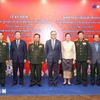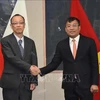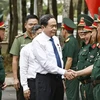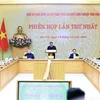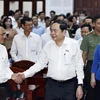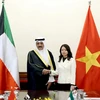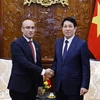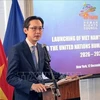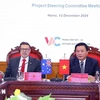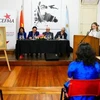The great victory of the resistance war against the US aggressors constitutes “the triumph of Vietnam’s military arts and guidelines under the Party’s sound and creative leadership”, General Secretary of the Communist Party of Vietnam (CPV) Nguyen Phu Trong has asserted.
In his article on the occasion of the 40th anniversary of Southern Liberation and National Reunification, the Party General Secretary, who is also Secretary of the CPV’s Central Military Commission emphasised that the great victory bears huge international significance and profound historical power.
It was a great fruit reaped by Vietnamese people, demonstrating the outstanding power of their revolutionary heroism, virtue, and intellect under the late President Ho Chi Minh’s leadership, he said.
Forty years ago, the general offensive in the spring of 1975—with the historic Ho Chi Minh Campaign as its pinnacle—ended successfully, leading to the ultimate victory of the resistance war against the US aggressors and the final reunification of the country. The resounding triumph created a turning point in national history, opening a new chapter of national independence and socialism.
According to the Party chief, between July 1954 and May 1975 the Party pursued independent and self-reliant political and military policies, holding the flag of national independence and socialism aloft. It concurrently launched the people’s democracy revolution in the South and the socialist revolution in the North, towards national independence, unification and socialism.
After the Paris Agreement was signed on January 27, 1973 and US troops pulled entirely out of Vietnam’s southern region on March 29, 1973, the battle changed significantly. In 1974, attacks were launched over southern battlefields, guided by the Party’s strategy of dismantling the enemy unit by unit. The general offensive in the spring of 1975 led to the ultimate victory.
The Party chief said “during the resistance war against the US aggressors, under the Party’s leadership, military arts used by Vietnam reached a crux”.
The Party paid special heed to Party work and political affairs in the army, especially during campaigns. It rallied the people’s power in terms of financial resources, political approval, strength and patriotism for the resistance war, he said.
He also praised the international community’s immense spiritual and material support as a crucial element to the triumph of the resistance war against the US aggressors.
“The Party, State, and army of Vietnam have never forgotten the whole-hearted assistance given by people from across the globe and fraternal socialist countries, especially the Soviet Union and China, to the just struggle of our nation,” the Party Chief said, giving special emphasis to the solidarity of the Vietnam-Laos-Cambodia alliance.
In his writing, the Party chief analysed regional and global situations and important achievements made by Vietnam during its 30-year renovation process, as well as difficulties and challenges, especially in defending the country’s island and sea sovereignty.
“The lesson learnt from the success of Party leadership in the resistance war against the US aggressors should be inherited and promoted in this new period of development,” he stressed.
He specified the lesson is about persistence in the goal of national independence associated with socialism, creatively and consistently applying Marxism-Leninism and Ho Chi Minh’s thought, firmly maintaining the nature of the working class, and fortifying the Party’s ideological foundation.
According to the Party chief, in order to increase the strength and health of the Party, the entire nation needs to continually implement the fourth Party Central Committee Resolution and continue learning and following the moral example of the late President Ho Chi Minh.
Efforts to prevent and combat corruption, waste and degradation in terms of political ideology, ethics, and lifestyle among Party members and State officials must be reinforced.
The fight against hostile forces is essential to firmly maintain the Party’s leadership and the socialist regime, he wrote.
The people’s army needs to speed up its efforts to build a “revolutionary, regular, elite and modern” military; comprehend situational context; and make accurate development forecasts. It should work closely with public security and foreign affairs forces to consult the Party and State on policies and strategies to defend the homeland and create a peaceful and stable environment to develop the country.
To that end, the Party’s absolute and comprehensive leadership over the army should be intensified, Party General Secretary Nguyen Phu Trong said, stressing focus on the political, ideological and organisational spheres of the CPV’s Central Military Commission to make it capable of leading the army to have a high combat capacity.
He also underlined the need to combat hostile forces’ apolitical schemes targeting the army.
The 85-year history and development of the Party show its firmness, intellect, virtue and sound leadership capability in difficult and complicated situations.
“We believe that the lessons from the success of the Party’s leadership in the spring of 1975, as well as during the entire struggle against the US aggressors to liberate the country, will continually be promoted in the new era,” the Party chief concluded.-VNA
In his article on the occasion of the 40th anniversary of Southern Liberation and National Reunification, the Party General Secretary, who is also Secretary of the CPV’s Central Military Commission emphasised that the great victory bears huge international significance and profound historical power.
It was a great fruit reaped by Vietnamese people, demonstrating the outstanding power of their revolutionary heroism, virtue, and intellect under the late President Ho Chi Minh’s leadership, he said.
Forty years ago, the general offensive in the spring of 1975—with the historic Ho Chi Minh Campaign as its pinnacle—ended successfully, leading to the ultimate victory of the resistance war against the US aggressors and the final reunification of the country. The resounding triumph created a turning point in national history, opening a new chapter of national independence and socialism.
According to the Party chief, between July 1954 and May 1975 the Party pursued independent and self-reliant political and military policies, holding the flag of national independence and socialism aloft. It concurrently launched the people’s democracy revolution in the South and the socialist revolution in the North, towards national independence, unification and socialism.
After the Paris Agreement was signed on January 27, 1973 and US troops pulled entirely out of Vietnam’s southern region on March 29, 1973, the battle changed significantly. In 1974, attacks were launched over southern battlefields, guided by the Party’s strategy of dismantling the enemy unit by unit. The general offensive in the spring of 1975 led to the ultimate victory.
The Party chief said “during the resistance war against the US aggressors, under the Party’s leadership, military arts used by Vietnam reached a crux”.
The Party paid special heed to Party work and political affairs in the army, especially during campaigns. It rallied the people’s power in terms of financial resources, political approval, strength and patriotism for the resistance war, he said.
He also praised the international community’s immense spiritual and material support as a crucial element to the triumph of the resistance war against the US aggressors.
“The Party, State, and army of Vietnam have never forgotten the whole-hearted assistance given by people from across the globe and fraternal socialist countries, especially the Soviet Union and China, to the just struggle of our nation,” the Party Chief said, giving special emphasis to the solidarity of the Vietnam-Laos-Cambodia alliance.
In his writing, the Party chief analysed regional and global situations and important achievements made by Vietnam during its 30-year renovation process, as well as difficulties and challenges, especially in defending the country’s island and sea sovereignty.
“The lesson learnt from the success of Party leadership in the resistance war against the US aggressors should be inherited and promoted in this new period of development,” he stressed.
He specified the lesson is about persistence in the goal of national independence associated with socialism, creatively and consistently applying Marxism-Leninism and Ho Chi Minh’s thought, firmly maintaining the nature of the working class, and fortifying the Party’s ideological foundation.
According to the Party chief, in order to increase the strength and health of the Party, the entire nation needs to continually implement the fourth Party Central Committee Resolution and continue learning and following the moral example of the late President Ho Chi Minh.
Efforts to prevent and combat corruption, waste and degradation in terms of political ideology, ethics, and lifestyle among Party members and State officials must be reinforced.
The fight against hostile forces is essential to firmly maintain the Party’s leadership and the socialist regime, he wrote.
The people’s army needs to speed up its efforts to build a “revolutionary, regular, elite and modern” military; comprehend situational context; and make accurate development forecasts. It should work closely with public security and foreign affairs forces to consult the Party and State on policies and strategies to defend the homeland and create a peaceful and stable environment to develop the country.
To that end, the Party’s absolute and comprehensive leadership over the army should be intensified, Party General Secretary Nguyen Phu Trong said, stressing focus on the political, ideological and organisational spheres of the CPV’s Central Military Commission to make it capable of leading the army to have a high combat capacity.
He also underlined the need to combat hostile forces’ apolitical schemes targeting the army.
The 85-year history and development of the Party show its firmness, intellect, virtue and sound leadership capability in difficult and complicated situations.
“We believe that the lessons from the success of the Party’s leadership in the spring of 1975, as well as during the entire struggle against the US aggressors to liberate the country, will continually be promoted in the new era,” the Party chief concluded.-VNA




